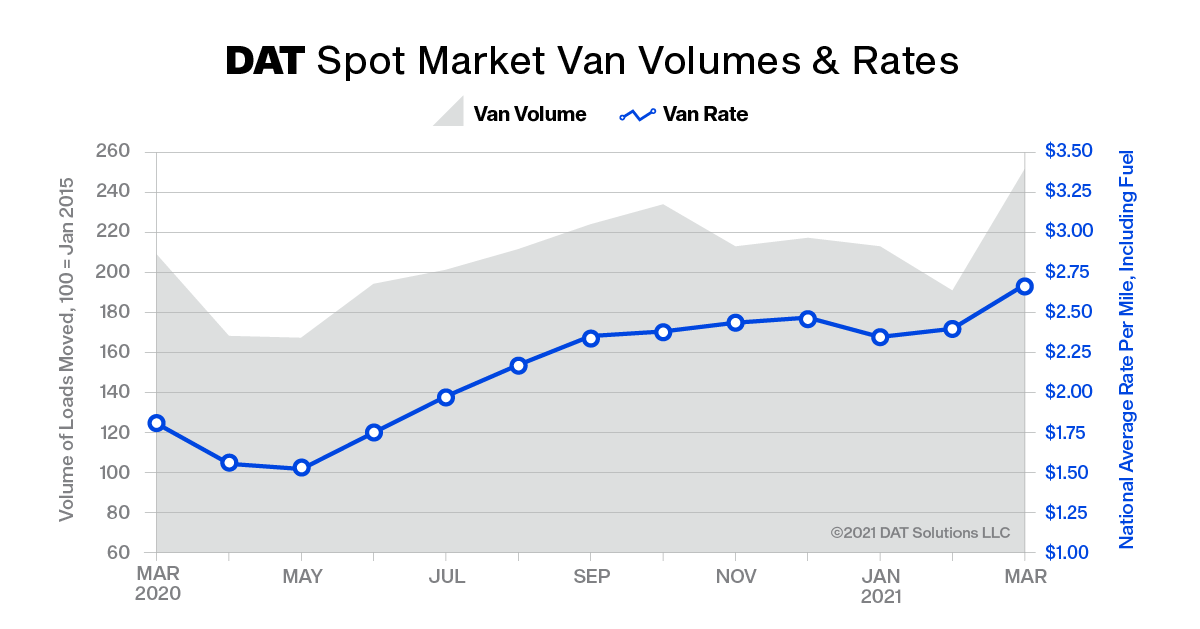BEAVERTON, Ore. — Spot truckload van and refrigerated freight rates hit all-time highs in March, according to DAT Freight & Analytics. Demand for flatbed transportation, driven by strong construction and manufacturing activity, also soared into record territory.
The total number of loads posted on the DAT network increased 22.3% month over month, while the number of available trucks was up 30.9%, indicating a return of traffic after being disrupted by winter storms in February.
The DAT Truckload Volume Index, a measure of dry van, refrigerated (reefer) and flatbed loads moved by truckload carriers, was up 31% in March to the highest level since the index was rebalanced in January 2015. The previous high was September 2020, when shippers were positioning freight for holiday shopping.
“The strength of truckload freight relative to the amount of capacity available in the market, combined with the willingness of shippers to pay high rates, indicates an urgency from businesses to fill orders and meet delivery schedules after a difficult February,” said Ken Adamo, chief of analytics at DAT. “All three equipment types that make up our Truckload Volume Index showed extraordinary growth at a time when capacity is tight and truckload prices are up.”
Van and reefer rates hit highs
The national average spot truckload van rate was $2.67 a mile, up 13 cents compared to February and almost 30 cents higher than the previous monthly average high in December 2020. The national average spot reefer rate was $2.95 per mile, up 25 cents compared to February and 20 cents higher than the monthly average contract rate.
The national average reefer load-to-truck ratio was 12.2, down from 15.9 in February, meaning there were 12.2 reefer loads on the DAT network for every available truck. The van load-to-truck ratio averaged 5.8, down from 7.5 in February, with high ratios in February being exacerbated by the severe winter weather that impacted much of the country.
Construction drives flatbed demand
Spot flatbed truckload rates and load-to-truck ratios are at their highest points since the mid-2018. The national average flatbed load-to-truck ratio was 83.7% in March, and spot flatbed volumes increased 34% compared to February on the strength of improved manufacturing output, a booming single-family housing market, and seasonal construction activity. The national average spot flatbed rate was $2.78 per mile, 20 cents higher than February.
DAT freight outlook
The national average contract van rate was $2.60 a mile in March, 7 cents less than the average spot van rate. The contract reefer rate was $2.75 a mile, 20 cents less than the spot reefer rate. When spot rates exceed contract rates, truckload carriers typically shift capacity to the spot market, creating uncertainty for shippers.
According to DAT analysts, year-over-year comparisons of truckload rates and volumes are now less relevant, given the effects of the pandemic on supply chains.
The impact of federal stimulus checks; an accumulation in household savings; component shortages in manufacturing; constraints and surcharges in intermodal networks; low inventories; and other supply chain disruptions at ports, canals and elsewhere could push the cresting of contract van and reefer rates into late in the second quarter of 2021.
A shortage of semiconductors and other components may delay production and delivery of heavy- and medium-duty trucks ordered in the fourth quarter of 2020 until late 2021 or early 2022, which would affect capacity.
The March blockage of Egypt’s Suez Canal is expected to have a negligible impact on U.S. supply chains compared to backlogs processing containers at U.S. West Coast ports. Congestion at the ports of Los Angeles and Long Beach, California, persisted as imports surged in March, as shown by the number of anchored vessels waiting to be offloaded, in addition to tight drayage and intermodal capacity coming off the ports.

The Trucker News Staff produces engaging content for not only TheTrucker.com, but also The Trucker Newspaper, which has been serving the trucking industry for more than 30 years. With a focus on drivers, the Trucker News Staff aims to provide relevant, objective content pertaining to the trucking segment of the transportation industry. The Trucker News Staff is based in Little Rock, Arkansas.








